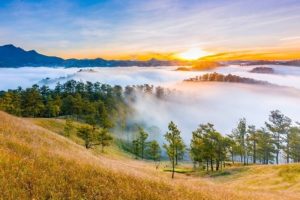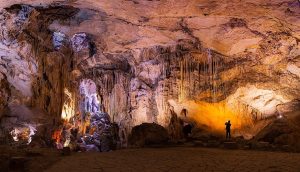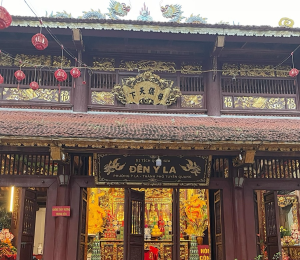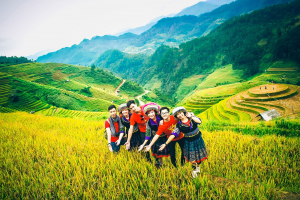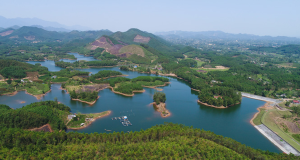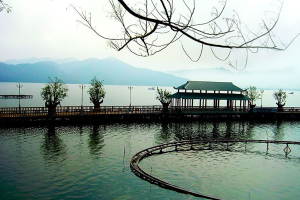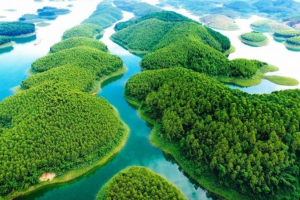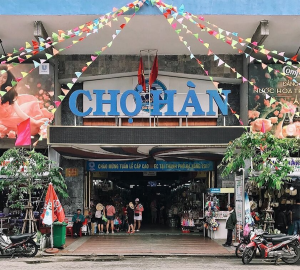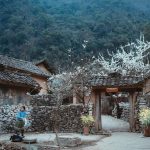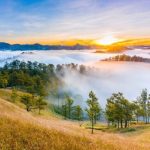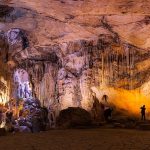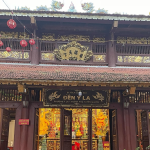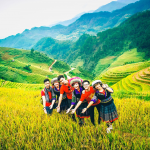
Mu Cang Chai is a small town in the isolated mountains in Vietnam’s northwest. It is recognized for its beautiful terraced rice fields and its unique seasonal rhythm. The weather in the area has a big impact on its natural beauty and farming practices. Anyone who wants to visit Mu Cang Chai, whether they’re a tourist looking for beautiful scenery or a photographer looking for the perfect moment, has to know about the weather there. This book will help you learn about the seasonal rhythms, the ideal times to travel, and the natural cycles that shape life in this beautiful highland area. To be able to admire all the beauty of this land, you need to know the Mu Cang Chai best time to visit.
Best time to visit Mu Cang Chai

The Mu Cang Chai best time to visit are during the watering season (May to June) and the ripening rice season (September to October). During these times, the terraced rice fields look their best. The terraces are full of water in May and June, which makes them look like beautiful mirrors. The fields turn a bright golden color in September and October when the rice is ready to eat. The wild peach flowers also look beautiful in late December.
- Watering Season: May to June The terraced rice fields are flooded, and the sky and other landscapes are reflected in the water. This is a stunning picture. Many people want to come here to admire the incredible beauty of Mu Cang Chai. When the rice is ready for harvest in September and October, the bright green rice paddies transform into a golden tapestry. You can see the golden rice and watch how locals harvest ripe rice.
- In December, wild peach trees bloom, covering the hillsides in pink and white. In this season, Mu Cang Chai changes to the beauty of cold dew in the early morning with the dew on the leaves. Visitors will see Mu Cang Chai in an entirely different appearance from the ripe rice season, carrying a sad and poetic look. This season is very suitable for virtual living activities or for relaxing in the unique atmosphere of Mu Cang Chai.
But other seasons are still times that you can consider if you don’t have much time in Vietnam:
- June to August (the middle of the crop season): The terraces are full of life and color, with rice plants growing well. You can participate in many outdoor activities, such as trekking and camping.
- Rainfall: Mu Cang Chai can get a lot of rain, especially in the summer. Get ready for possible rain and pack accordingly. Many people choose to visit Mu Cang Chai in this season because this is not the peak season. Few tourists come to visit, making it suitable for those who like peace and freedom to sightsee.
Acttually, Mu Cang Chai best time to visit is around the year. Each season has its unique beauty. Each seasn is suitable for kinds of visitors. So if you want to choose the Mu Cang Chai best time to visit, you should choose to depend on your characteristics and time to be in Vietnam.
Mu Cang Chai’s seasons explained

Mu Cang Chai is in the northwest mountains of Vietnam and has a subtropical highland climate with two distinct seasons: the cold and dry season from November to March and the hot and rainy season from April to October. The weather in the area has a big effect on its landscapes and farming cycles.
- The cold and dry season lasts from November to March
Temperatures are colder now, especially at night in December and January. There isn’t much rain, and the skies are usually clear, so it’s a wonderful time to hike, view the sights, and learn about the local culture. Because the area is so high up, there may be Mist or fog in the early morning and late evening, which adds a magical touch to the scenery.
- The hot and rainy season lasts from April until October
The weather becomes warmer this time of year, and most of the area’s rain falls during this period. However, the rain typically falls in small amounts and does not last long, resulting in dry periods throughout the day. The rainy season is also important for keeping the region’s famous terraced rice fields alive by keeping the soil moist and fertile.
So Lily’s Travel suggests times for planting and harvesting that you should choose: April and May are the start of the farming season. During this time, farmers get the ground ready, flood the terraces, and plant rice. People call this time of year the “water-pouring season” because the flooded terraces make beautiful reflections of the sky and mountains. That is called the Mu Cang Chai best time to visit and the most favorite time to visit.
The rice ripens and turns yellow from September to October, which means it’s time to harvest it. This phase is when Mu Cang Chai turns into a golden environment that draws in tourists and photographers from all over the world.
Weather tips for visiting Mu Cang Chai

To get the most out of your trip to Mu Cang Chai, you need to know the weather. The weather shapes theperiod of land and affects its accessibility and beauty year-round.
The greatest times to visit are in May, when the water is high, and from September to October, when the crops are ready to be picked. In May, the newly flooded terraced fields resemble natural mirrors reflecting the sky. This is a great place for photographers and nature lovers. In this period time, on the other hand, the rice harvest is at its pinnacle. The hills are covered in golden rice, which is the most famous view of Mu Cang Chai.
The summer months (June to August) are part of the wet season, so you should be careful throughout these months. Even while the rains are usually short and scattered, they can make roads slick and make landslides more likely in more distant regions. If you want to go hiking or riding your motorcycle outside during this time, it’s best to check the local forecast often and talk to people who live there before you go.
The weather in the highlands can be unpredictable at any time of year, but it’s especially severe in the early mornings and evenings. The weather can change quickly, so make sure to bring layers, including a light jacket or sweater. Furthermore, if you’re going during the wet months, it’s a good idea to bring waterproof shoes and a raincoat or poncho.
If you want clearer skies and drier weather, the cold and dry season from November to March can be a good time for you to travel. The rice fields are quiet, and the view is less colorful than during planting or harvest, even if the weather is usually stable because of the local farming timetable. It is crucial to stay on the designated paths and avoid stepping on the crops, as farmers are currently working in the fields. If you plan your trip around the weather and the growing seasons, you’ll not only avoid unpleasant surprises, but you’ll also see Mu Cang Chai in its most beautiful times.
FAQs about the Mu Cang Chai best time to visit

To maximize your trip, you must know how weather affects travel and the environment year-round and can choose Mu Cang Chai best time to visit.
Read more: Ban Gioc Waterfall: Where nature splits two nations
When is the harvest festival held?
The Mu Cang Chai harvest celebration, also known as the Mung Xoong festival, usually happens in September and October when the rice on the terraced fields is ready to be picked. As the rice fields turn yellow, the scenery changes into a gorgeous golden color.
Can you visit during the rainy season?
Lily’s Travel states that visiting Mu Cang Chai during the rainy season is possible, but you should be prepared for some challenges. From May to October, during the rainy season, there are strong rains that can make trails muddy and even create landslides, especially when riding a motorcycle. But it also has lovely views, including flooded rice terraces that mirror the sky, which is great for photographers. The rain can also make it colder, which might be a refreshing contrast from the heat.
Is winter a good time to go?
Winter (December to February) is not usually the greatest time to go to Mu Cang Chai. The weather is cool and dry, which some like, but the scenery isn’t as colorful as in other seasons. During the winter, the rice terraces aren’t flooded for planting or golden for harvesting. But you could try to have more experience with winter in Vietnam if you wish.
Mu Cang Chai best time to visit is during the watering season, from May to July every year. However, not all foreign tourists can arrange to come to Vietnam at this time. Therefore, if you travel to Vietnam at other times, you can still visit Mu Cang Chai and experience other activities here. Although it is not the season when Mu Cang Chai becomes the most beautiful, there are still many local activities taking place. And to know what these activities in Mu Cang Chai are, please contact Lily’s Travel immediately for answers as well as specific schedule advice to be able to experience Mu Cang Chai most fully.
Read more: Hanoi to Ban Gioc Waterfall: Go off the beaten path



